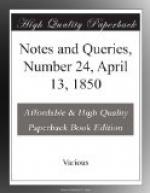“1646. Oc’r
1. William Young, Chandler, within Aldersgate,
a
discreet Juryman, and Barba
Longa, died.”
“Fe’r 21., old M’r Lewis, the Mercenary Preacher, buried.”
Can any of your correspondents explain the meaning of “Trunck Breeches,” “Barba Longa,” and “Mercenary Preacher?”
X.Y.Z.
Suffolk, March 4.
Apposition.—Can any one give me a little information upon the following passage?—
“Quin age, te incolumi potius (potes
omnia quando,
Nec tibi nequiequam pater est qui sidera
torquet)
Perficias quodcunque tibi nunc instat
agendum.”
Hieronym. Vid. Christ. lib. i. 67.
I want to know in what case te incolumi is; and, if in the ablative absolute, can any one bring a parallel construction from the writers of the Augustan age, where the law of apposition appears to be so far violated?
A.W.
Pamphlets respecting Ireland.—“J.” wishes to be informed where copies may be found of the following pamphlets, described in Ware’s Irish Writers, under the head “Colonel Richard Laurence,” and “Vincent Gookin, Esq.,” son of Sir Vincent Gookin, who, in the year 1634, published “a bitter invective, by way of letter, against the nation.” Vincent Gookin’s pamphlet is dated London, 1655, 4to. Any particulars relative to his family and descendants will oblige.
The title of Col. R. Laurence’s book is,—
“The interest of Ireland in the first Transplantation stated; wherein it set forth the benefit of the Irish Transplantation: intended as an Answer to the scandalous seditious Pamphlet, entitled ‘The Great Case of Transplantation Discussed.’ London, 1655.”
The author of the pamphlet was Vincent Gookin, Esq., Surveyor-General of Ireland. He did not, at first, put his name to it; but when Laurence’s answer appeared, he then owned himself as the author of it, and published a pamphlet under this title:—
“The Author and Case
of Transplanting the Irish into Connaught
Vindicated from the unjust
Aspersion of Colonel Richard
Laurence and Vincent Gookin,
Esq. London, 1655.”
Portrait of Sir John Poley.—Perhaps some of your numerous correspondents can answer whether the portrait of Sir John Poley in Bexstead Hall, alluded to No. 14. p. 214., has been engraved.
J.
February 5.
“Tace is Latin for a candle.”—Whence is this expression derived, and what is its meaning? I met with it, many years ago, in a story-book, and, more lately, in one of the Waverley Novels, in which particular one I do not just now recollect. It seems to be used as an adage, coupled with an admonition to observe silence or secrecy.
W.A.F.
Poins and Bardolph.—Can any of your correspondents skilled in Shakspearian lore inform me whence Shakspeare took the names Poins and Bardolph for the followers of Prince Hal and Falstaff?




